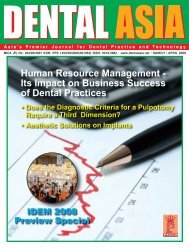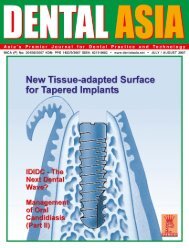Download - Dental Asia
Download - Dental Asia
Download - Dental Asia
You also want an ePaper? Increase the reach of your titles
YUMPU automatically turns print PDFs into web optimized ePapers that Google loves.
CLINICALFEATURE<br />
by Dr Bertrand Chew<br />
Post-Minor Oral Surgery Pain<br />
Management with Oral Medication<br />
Pof Analgesics, there are the Acetaminophen,<br />
ain control is of paramount importance in post surgical<br />
management. The common drugs groups used are<br />
Analgesic and Anti-inflammatory Drugs. In the family<br />
Acetylsalicylic acid, NSAIDs(inclusive of the COX II-inhibitors)<br />
and the Opioids.<br />
In the pharmaceutical control of pain in the oral region, it acts<br />
on the pain pathways at different levels. The Spinothalamic<br />
(trigeminal-thalamic) tract is that carries the sensation of pain.<br />
The Chemical pathways of pain involves a cascade of events in<br />
cells, involving products of cells, enzymes, soluble factors, and<br />
blood vessels and their contents (Enwemeka & Spielholz 1992;<br />
Schmidt et al 1994; Tillman & Cummings 1992).<br />
Acetaminophen, 4'-hydroxyacetanilide, is an analgesic and<br />
antipyretic which occurs as a white, odorless, crystalline<br />
powder, possessing a slightly bitter taste. It has the following<br />
molecular formula C8H9NO2 with a molecular weight of<br />
151.16. It is discovered by accident when a similar molecule<br />
(acetanilide) was added to a patient’s prescription<br />
approximately 100 years ago. The medication is commonly<br />
known as Paracetamol = para-acetyl-amino-phenol.<br />
To date, the exact mode of action is still being discussed. The<br />
pain-reducing effect is more directly on the central nervous<br />
system by increasing the threshold of pain. There is an<br />
inhibition of the actions of chemical mediators that sensitize the<br />
pain receptors to mechanical or chemical stimulation. It also<br />
blocks activity by reducing the active oxidized form of cyclooxygenase<br />
to an inactive form and hence has little<br />
inflammatory actions (Lucas R et al 2005). The antipyretic<br />
activity is exerted by blocking the effects of the chemical<br />
pyrogen on the hypothalamic heat-regulating center.<br />
Others mention inhibition of nitric oxide formation that results<br />
from activation of substance P and N-methyl-D-aspartate<br />
(NMDA) receptor stimulation. Acetaminophen is metabolized by<br />
the liver. Therefore drugs that increase the action of liver<br />
enzymes that metabolize acetaminophen (eg carbamazepine,<br />
isoniazid, rifampin) may decrease the action of acetaminophen.<br />
The potential for acetaminophen to harm the liver is increased<br />
when it is combined with alcohol or drugs that also harm the<br />
liver. Acetaminophen is used in all stages of pregnancy. Breastfeeding<br />
is not a contraindication. (Gramham et al 2005)<br />
Drug Safety<br />
There is no clear evidence that taking paracetamol causes<br />
asthma, but more studies are suggesting that may be some<br />
association. Studies of patients with asthma suggest that<br />
acetaminophen challenge can precipitate a decline in FEV(1) ><br />
15% among sensitive individuals. (Eneli et al 2005). Some<br />
patients may have a specific sensitivity to the active ingredient<br />
or to any of the other components of the paracetamol.<br />
Paracetamol can be combined with many other drugs.<br />
They include the following:<br />
1. Orphenadrine citrate-analgesic properties. Also possesses<br />
anti-cholinergic actions. Good for muscle aches. (Aanarex)<br />
2. Caffeine (Panadol Extra)<br />
3. Codeine Phosphate (Panadeine)<br />
4. both codeine and Caffeine. (PACOFEN)<br />
5. Pamabrom: a diuretic to ease water retention. (for<br />
menstrual)<br />
6. Tramadol (Ultracet)<br />
Acetylsalicylic acid is commonly known as Aspirin. The chemical<br />
name 2-(acetyloxy) benzoic acid, are used as an analgesic,<br />
antipyretic and anti-inflammatory. It has also an anticoagulant<br />
effect and is used in long-term low-doses to prevent heart<br />
attacks. The bitter powder is extracted from willow bark that<br />
could ease aches and pains and reduce fevers. It was further<br />
modified by by researcher Arthur Eichengrun and Felix Hoffmann<br />
in1897.Aspirin was patented on March 6, 1899 by Bayer.<br />
Aspirin suppresses the production of prostaglandins and<br />
thromboxanes. This happens because cyclooxygenase (COX),<br />
an enzyme that participates in the production of prostaglandins<br />
and thromboxanes, is irreversibly inhibited when aspirin<br />
acetylates it. This makes aspirin different from other NSAIDS,<br />
which are reversible inhibitors. (John Robert Vane 1982).<br />
The topic on the safety of extractions on ling term aspirin<br />
patient has been discussed many times. The following<br />
statement would be a very useful guide: The scientific literature<br />
does not support routine discontinuation of oral anticoagulation<br />
therapy for dental patients (Jeske et al 2003).The<br />
management of oral surgery procedures on patients treated<br />
with anti-coagulants should be influenced by several factors:<br />
extent and urgency of surgery, laboratory values, treating<br />
40 <strong>Dental</strong> <strong>Asia</strong> • May / June 2008





